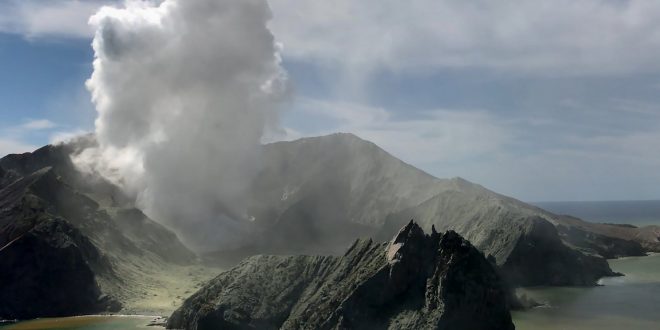Authorities vow to return to recover eight bodies but ‘significant increase’ in volcanic activity leads to delays
New Zealand police have vowed to return to White Island to retrieve the bodies of eight tourists who died there, as the first Australian victims of the volcanic eruption were named.
Police efforts to reach the island were thwarted on Wednesday as volcanic activity increased, making it too dangerous for disaster victim identification officers to land. However, police did manage to conduct four flyovers of the island and were analysing footage taken by a drone.
As victim’s families grew increasingly anxious about when their loved ones would be returned home, police deputy commissioner John Tims promised his officers wouldn’t rest till the bodies came home.
“Our number one priority is to return to the island and recover those bodies,” he said.
The identities of several victims began to emerge on Wednesday. Gavin Dallow, from Adelaide, was named by his family as one of the dead. The body of his 15-year-old step-daughter Zoe Hosking is believed to still be on the island.
Gavin’s father, Brian Dallow, praised his son as “a person who was always interested in helping other people” and enjoyed a range of sports. He said Gavin was the kind of person who “if he’d known there was a danger he wouldn’t have gone”.
“At Christmas we’re really going to miss him.”
A family statement said: “Our hearts break at the loss of Zoe at such a young age. We know her loss will also devastate her school community and the local Girl Guides, of which she was an active member.”
A Brisbane mother and daughter, Julie Richards, 47, and 20-year-old Jessica, who were passengers on Ovation of the Seas, were also confirmed by family members to have died.
John Mickel, a friend of the Richards’, said the family was “united in grief”.
Police also named Krystal Browitt, Richard Elzer and Karla Matthews as among the missing from Australia and Tipene Maangi and Hayden Inman from New Zealand.
Tims said the Australian Defence Force was arriving soon to repatriate injured Australians and one Australian had already been privately flown from Wellington to Sydney for treatment. Australia had also sent medical supplies and diplomatic personnel to New Zealand.
As the names of some of the deceased emerged, New Zealand activated its burn disaster national response plan for the first time. As of Wednesday morning, 30 people were in hospital and 25 were in a critical condition as a result of burns. The ministry of health said 120 square metres of skin was being sent from the US to treat victims struggling for life in six New Zealand hospitals.
Operating theatres were working around the clock, said Ashley Bloomfield from the ministry of health, and almost all patients had now been identified, though this process took longer than expected due to many being unconscious and lacking identification.
Dr Peter Watson, the Counties Manukau chief medical officer, said 22 patients from White Island still required breathing support.
“The nature of the burns suffered is complicated by the gases and chemicals in the eruption. This has necessitated more rapid treatment of these burns than is the case for thermal-only burns.” Watson said.
A scientist from GNS Science, Graham Leonard backed up police’s decision not to return to the island, saying conditions were worsening and it would be challenging for people to breathe, see or walk on the disaster site.
Leonard said the risk of another eruption like Monday’s had increased and there was now a 40-60% chance of one in the next 24 hours.
Sarah Stuart-Black, the management director of the National Civil Defence, said it was “absolutely imperative” the bodies were retrieved as soon as was safely possible, as families were beginning to arrive from overseas to Whakatāne.
White Island’s alert level remained at three but volcanologist Craig Miller said “volcanic tremor significantly increased” on the island around 4am, indicating that volcanic gas pressures remained high.
“This has been accompanied by vigorous steaming and localised mud jetting in several of the craters created by the eruption on Monday,” Miller said. “The situation remains highly uncertain as to future activity.”
As the wait for the recovery mission lengthened, local people in the Bay of Plenty expressed frustration at the multiple delays and the lack of information from police, including any discussion of the details of the recovery plan or how long it would take.
“Let’s stop talking about it and do it,” says Ben Smith, 44, a local orchard worker. “I think they are over-rationalising it. You have to take that information from all the scientists into account but also listen to the locals. They know the island and the weather as good as anyone.”
Some likened the situation in Whakatāne to the Pike River Mine disaster in Greymouth in 2010. The bodies of 29 miners remain entombed in the mine nine years after a blast in the mine.
“I’m old school and it’s been frustrating me,” said BJ Hawthorn, 51, a bobcat driver. “This country has got extremely PC and out of control when it comes to worksafe conditions. Just go and get them. I know guys in the fire brigade here who just want the opportunity to go and get them. If there’s a car on fire you don’t wait until someone puts road cones around it.”
Paul Quinn, the chair of White Island tours, said iwi were “wrapping the necessary support around affected families and staff, all of whom are understandably distraught”, and support care packages were being put together for those families as they await news on the recovery mission.
“There are many questions that are left to be answered but our priority at this time is on the welfare of those affected,” Quinn said in a statement.
Some in the town said they think tourists should never have been allowed on White Island – and never should be again. Hinepare Tawa, 32, a local mother-of-four said: “My belief is that Whakaari is a living being, an ancestor, and I don’t believe she is a person to be disturbed. If the island was closed I wouldn’t be too worried about it.”
The Guardian
 Lebanese Ministry of Information
Lebanese Ministry of Information



